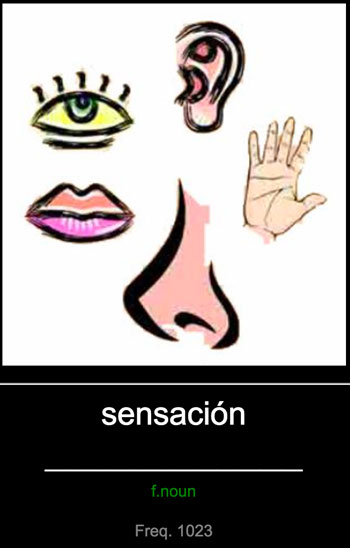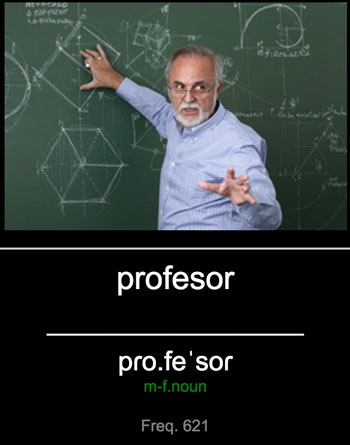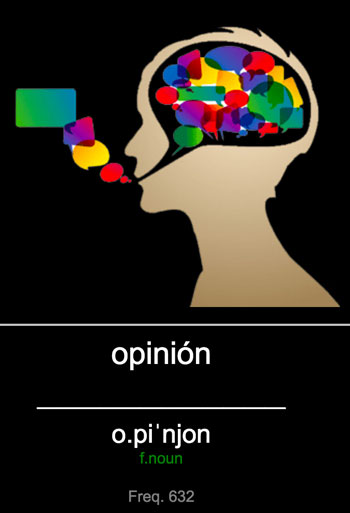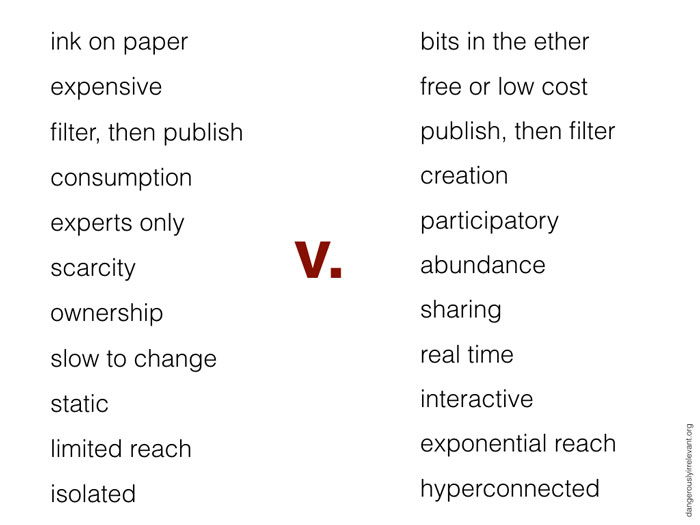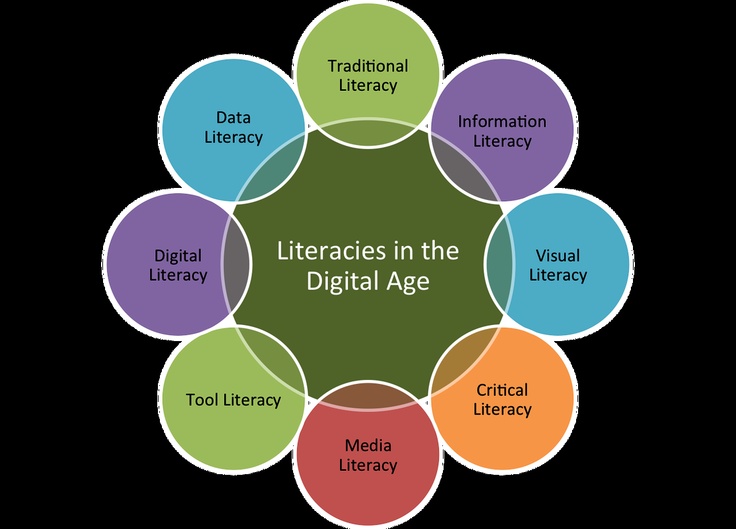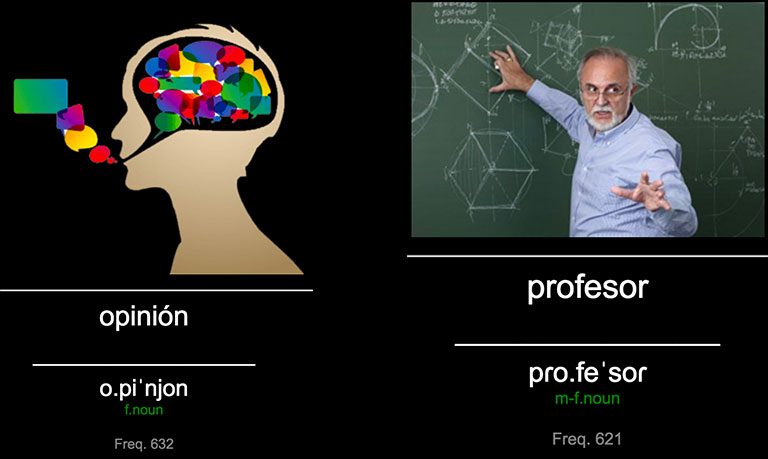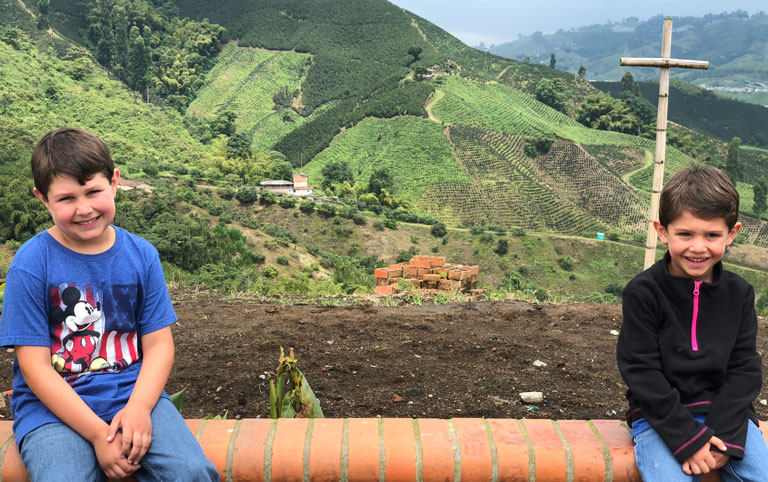What are the most optimal first words to learn in Spanish for English speakers?
After putting more thought into it than I care to admit, the answer seems obvious (in retrospect.) Actually, you already know them, but probably didn’t realize they were Spanish words as well as English. More importantly, they are high frequently words. Spanish speakers use them all the time, and so will you if you learn Spanish. In fact, you already use them all the time, but in English.
Three Optimal Things
Three things about these words make them optimal first words to learn in Spanish:
- They are very frequently used.
- You already know them.
- You can focus exclusively on learning to pronounce them (since you already know them.)
Too good to be true? That was my first reaction when I created the list. As you’ll see, it’s more like “the time has finally come.”
Hiding in Plain Sight for Centuries
These words have been hiding in plain sight for centuries. They are perfect (285), and near-perfect (226), high-frequency English-Spanish cognates. That is, they have the same spelling and meaning in English and Spanish and are (very) frequency used in both languages.
What’s kept them hidden is not knowing which cognates (of thousands) are the most frequently used. All the words on the 500 Optimal First Words list are in the top 5000 most frequently used words in Spanish. And 277 of them are in the top 3000! That makes them pure gold for the student first learning Spanish.
To put that in perspective, you would understand ~90% of every word spoken or written in Spanish if you knew the top 3000 words. And, your comprehension would rise to 95% if you understood the top 5000 words.
All this, and yet, for English speakers learning Spanish, it gets (much) better.
50% of the Top 5000 Words in Spanish are Cognates!
Yes, it’s true. English speakers who want to learn Spanish get a 50% head start on the most critical words in the language.
After learning that they exist, and how to pronounce them, English speakers can say plenty (in Spanish) after learning a bit of grammar. That’s a reversal of the common complaint of being made to learn grammar and having no vocabulary with which to say anything.
To get to 50%, the top cognate verbs must be included. Verbs make up 477 of these 2500 cognates in the top 50%. As in any language, you’ll have to learn how to use verbs. But, 477 of them will be words whose meaning you already understand.
Why Doesn’t Every Spanish Teacher Start with This List?
They probably will. But, until now, it’s been impossible to formulate such a list without a decent frequency dictionary.
There’ve been six efforts to create a Spanish frequency dictionary starting in 1927. They all suffered from significant limitations before Mark Davies’ breakthrough version in 2006 (book title here). That was only 12 years ago.
It takes exposure and lots of time to incorporate new information into accepted pedagogy. To my knowledge, even online curriculum providers are just starting to integrate Davies’ work into their approach to teaching Spanish.

The Cost of Cognate Acquisition: Pronunciation
You already know what they mean, how to spell them, and how to pronounce them in English. But you can’t use them in Spanish until you can pronounce them in a way that a Spanish speaker can hear them. And you have to tune your ear so that you can hear and understand them when spoken in Spanish, as well.
English and Spanish share an almost identical alphabet. But Spanish is pronounced differently enough, that the same exact word (spelled the same, with the same meaning) is unlikely to be understood if you don’t pronounce it, correctly.
Listen to a Spanish Native Speaking Perfect English
If you don’t believe me about how important pronunciation is, (and have a smartphone or tablet) go to your settings and change your language to Spanish. Then, highlight an English sentence and have it read aloud to you by the Spanish voice (which uses the Spanish rules of pronunciation.)
Don’t be surprised when “Juan” or “Paulina,” says something incomprehensible. How could that be? You’ve highlighted a correctly written English sentence to be read aloud!? Yes, and you’re hearing how a native Spanish speaker would pronounce that English sentence using the Spanish rules of pronunciation. It sounds like gibberish to an English listener.
By the way, that’s the way you sound, in reverse, to Spanish speakers when you pronounce correctly written Spanish sentences using the English rules of pronunciation.
Same Words, Worlds Apart
When in Colombia on a recent trip and talking with my aunt (who only speaks Spanish) I was finally able to form perfect Spanish sentences and was excited to say something that involved the word ‘video.’ Imagine my surprise when she had no idea what I was talking about!
The problem? I pronounced ‘video’ like the English word that it is. In Spanish, ‘vidéo’ has an accent over the second syllable. Trust me when I tell you that ‘video’ and ‘vidéo’ mean the same thing, but are worlds apart when mispronounced from your listener’s point of view.
Unless each speaker adjusts their pronunciation to the listener’s language, even perfectly formed sentences using the same alphabet (In either English or Spanish) sound like gibberish!
We might remember this when tempted to criticize each other’s “accents.”
Perfect and Non-Perfect Cognates
285 words in the 500 Optimal First Words list are perfect cognates. They have the same meaning and are spelled the same, in English and Spanish. I’ve allowed for the Spanish accent mark placed over the same letter, e.g., mamá vs. mama, réplica vs. replica. I’ve also allowed for words spelled with two letters in English, ‘accessible,’ but only one letter in Spanish, ‘accesible.’
The 226 non-perfect cognates on the list allow for minor spelling changes such as replacing the ‘t’ with ‘c’ in ‘edición’ vs. ‘edition’ and ‘nacional’ vs. national. They also allow for an ‘o’ or ‘a’ after the word as in ‘humano’ vs. ‘human’ and ‘diferente’ vs. ‘different.’
It’s a rare (non-existent?) student who might be thrown off by the minor spelling changes I’ve allowed for in the ‘non-perfect’ portion of the list. I’ve kept it strict to enable the student to focus almost exclusively on pronunciation.
But What about Verbs & Grammar?
Cognates should come first. Every cognate you learn (to pronounce) in the top 5000 is pure gold! In fact, you rarely hear a Spanish sentence without one.
I’m teaching my children to go as far as they want with cognates until they’re ready for a change of subject or pace. Besides that, they are only 9 and 5 years old, and many of the cognates are words they are learning in English for the first time. That’s double points for homeschoolers!
Verb Cognates
There are 477 near-cognate Spanish verbs in the top 5000. But verb endings in the infinitive are “foreign” to the English ear, and more than two letters need be modified from their English counterpart. Therefore, the low-hanging fruit of noun and adjective cognates should come first, in my opinion. Only then can the student focus exclusively on pronunciation (crucial skill #1) and ear-training (crucial skill #2) from the start.
Grammar Madness
Putting grammar before words is demotivating. Why put students through a grammar lesson when they have no words with which to apply that grammar?
By learning cognates first, the student emerges with lots of words and excellent pronunciation.

The First 100
Here’s the first 100 of the 500 optimal first words list. Four words appear twice: once as a noun, and again as an adjective. The fact that these words (solo, final, presente, and total) appear twice in the top 5000 words makes them pure gold. Instead of being disappointed that they’re the same, celebrate them as getting two high-frequency words in one. But, just in case it makes you feel cheated, I’ve added four more to the list for a total of 104.
The First 100 Optimal First Words to Learn in Spanish
| Word |
IPA |
Function |
Frequency |
| solo |
’solo |
adv. |
102 |
| momento |
|
m.noun |
108 |
| solo |
’solo |
adj. |
160 |
| problema |
|
m.noun |
169 |
| historia |
|
f.noun |
192 |
| idea |
i’ðea |
f.noun |
193 |
| familia |
faˈmi.lja |
f.noun |
201 |
| importante |
|
adj. |
207 |
| humano |
|
adj. |
218 |
| posible |
|
adj. |
225 |
| general |
xene’ɾal |
adj. |
227 |
| relación |
|
f.noun |
230 |
| situación |
|
f.noun |
268 |
| social |
so’θjal |
adj. |
280 |
| español |
|
adj. |
285 |
| final |
|
mf.noun |
307 |
| condición |
|
f.noun |
341 |
| color |
koˈloɾ |
m.noun |
359 |
| experiencia |
|
f.noun |
361 |
| diferente |
|
adj. |
365 |
| natural |
natu’ɾal |
adj. |
414 |
| atención |
|
f.noun |
441 |
| real |
re’al |
adj. |
462 |
| ocasión |
oka’sjon |
f.noun |
463 |
| favor |
fa’βoɾ |
m.noun |
468 |
| principal |
pɾinθi’pal |
adj. |
496 |
| animal |
a.niˈmal |
m.noun |
497 |
| base |
’base |
f.noun |
498 |
| posición |
|
f.noun |
503 |
| nacional |
|
adj. |
507 |
| superior |
supe’ɾjor |
adj. |
535 |
| función |
|
f.noun |
543 |
| grave |
’gɾaβe |
adj. |
548 |
| decisión |
deθi’sjon |
f.noun |
549 |
| música |
ˈmu.si.ka |
f.noun |
550 |
| expresión |
ekspɾe’sjon |
f.noun |
555 |
| producto |
|
m.noun |
589 |
| personal |
peɾ.soˈnal |
adj. |
590 |
| imposible |
im.poˈsi.βle |
adj. |
592 |
| plan |
’plan |
m.noun |
598 |
| origen |
o.ɾiˈxen |
m.noun |
606 |
| interior |
in.te.ˈɾjoɾ |
m.noun |
614 |
| profesor |
pɾo.feˈsoɾ |
m-f.noun |
621 |
| total |
to’tal |
adj. |
629 |
| opinión |
o.piˈnjon |
f.noun |
632 |
| profesional |
pɾo.fe.sjoˈnal |
adj. |
640 |
| capital |
ka.pi.ˈtal |
mf.noun |
651 |
| material |
ma.teˈɾjal |
m.noun |
656 |
| simple |
’simple |
adj. |
661 |
| normal |
noɾ’mal |
adj. |
664 |
| actual |
äk’twäl |
adj. |
676 |
| información |
|
f.noun |
682 |
| popular |
popu’laɾ |
adj. |
709 |
| error |
eˈroɾ |
m.noun |
738 |
| reunión |
rew’njon |
f.noun |
746 |
| final |
fi’nal |
mf.noun |
771 |
| civil |
θiˈβil |
adj. |
774 |
| doctor |
d̪okˈtor |
m-f.noun |
778 |
| construcción |
|
f.noun |
794 |
| presente |
|
m.noun |
802 |
| director |
di.ɾek’toɾ |
m-f.noun |
816 |
| radio |
ˈra.ðjo |
mf.noun |
824 |
| educación |
|
f.noun |
845 |
| operación |
|
f.noun |
848 |
| particular |
paɾtiku’laɾ |
adj. |
854 |
| solución |
|
f.noun |
871 |
| intención |
|
f.noun |
876 |
| control |
kon’tɾol |
m.noun |
889 |
| conversación |
|
f.noun |
892 |
| generación |
|
f.noun |
906 |
| visión |
bi’sjon |
f.noun |
908 |
| labor |
la’βoɾ |
f.noun |
930 |
| revolución |
|
f.noun |
957 |
| maestro |
ma’estɾo |
m.noun |
961 |
| plaza |
’plaθa |
f.noun |
1020 |
| sensación |
|
f.noun |
1023 |
| obligación |
|
f.noun |
1040 |
| total |
to’tal |
m.noun |
1043 |
| región |
re.ˈxjon |
f.noun |
1050 |
| discusión |
dis.ku’sjon |
f.noun |
1055 |
| central |
θen.ˈtɾal |
adj. |
1062 |
| televisión |
te.le.βiˈsjon |
f.noun |
1078 |
| moral |
mo.ˈɾal |
adj. |
1082 |
| crisis |
ˈkɾi.sis |
f.noun |
1085 |
| presente |
|
m.noun |
1088 |
| sector |
sek’tor |
m.noun |
1096 |
| accidente |
|
m.noun |
1098 |
| oficial |
ofi’θjal |
adj. |
1099 |
| intelectual |
intelek’twal |
adj. |
1103 |
| institución |
|
f.noun |
1115 |
| conclusión |
konklu’sjon |
f.noun |
1138 |
| exterior |
eks.teˈɾioɾ |
adj. |
1163 |
| cámara |
ˈka.ma.ɾa |
f.noun |
1172 |
| creación |
|
f.noun |
1173 |
| internacional |
|
adj. |
1189 |
| original |
o.ɾi.xi’nal |
adj. |
1191 |
| profesión |
pɾofe’sjon |
f.noun |
1206 |
| honor |
o’noɾ |
m.noun |
1211 |
| organización |
|
f.noun |
1243 |
| café |
kaˈfe |
m.noun |
1250 |
| americano |
|
adj. |
1261 |
| interior |
in.te.ˈɾjoɾ |
m.noun |
1263 |
| cultural |
kul’tuɾal |
adj. |
1277 |
| hospital |
os.piˈtal |
m.noun |
1298 |

Anki Deck with All 500 Words
I’ve made an Anki flashcard deck with all 500 words. Anki is a free digital flashcard program that enables the use of pictures, audio, video, and has lots of other great features to optimize recall. The cards can be viewed on a smartphone, tablet, or computer.
After you’ve viewed a card twice, Anki uses a spaced repetition algorithm to show you the card again at just the right time to optimize recall. This is called SRS or spaced repetition system and it was invented by Dr. Piotr Wozniak.
Each word in the 500 Optimal First Words deck has a picture, audio pronunciation in perfect Spanish, the IPA symbol, the function of the word, and its frequency rank in Spanish.
There are two cards for each word so they can be viewed forwards (Word on the front, picture and sound on the back) and backward (Picture on the front, word and sound on the back.)
These flashcards are suitable for anyone learning Spanish. The pictures are the best illustration of the word I could find and are also child-friendly. Here’s what the cards look like after both sides have been revealed.

